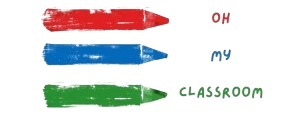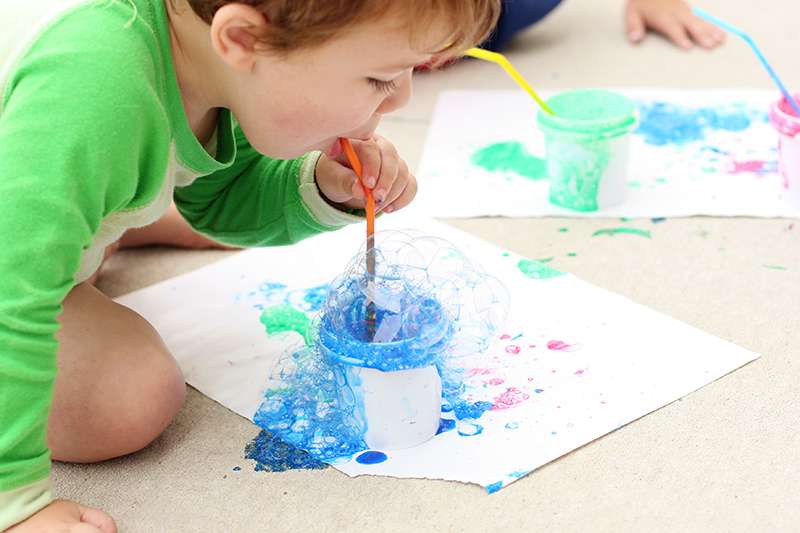Bubble painting is a fun and interactive art activity that can captivate the imagination of preschoolers.
With its vibrant colors and magical bubbles, this activity offers a unique way for children to explore their creativity and create beautiful artwork.
Bubble painting is not only entertaining but also provides a sensory experience that stimulates fine motor skills and hand-eye coordination.
Now, we will present Exciting and Easy Bubble Painting for Preschoolers.
So, grab your bubble solution, and let’s dive into the colorful world of bubble painting!
Bubble Snake Creations:
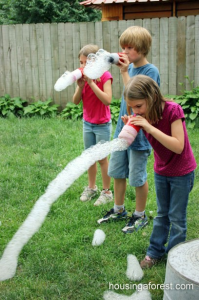
Preschoolers will love creating their very own bubble snakes using simple materials. Cut off the bottom of a plastic bottle and attach a sock or cloth over it with a rubber band. Dip the sock end into a mixture of liquid soap and water, then blow through the bottle’s top to create long bubble snakes on paper. Kids can experiment with different colors and patterns by adding food coloring to the bubble mixture.
Bubble Wrap Roller Painting:

Transform bubble wrap into a unique painting tool by wrapping it around a rolling pin or a cardboard tube. Dip the bubble wrap in a shallow tray of paint and roll it across the paper, creating a mesmerizing textured pattern. Preschoolers can explore different color combinations and experiment with rolling techniques to produce a variety of designs.
Related: 20 Best Playdough Activities for Preschoolers
Bubble Printing with Household Objects:

Encourage preschoolers to explore their surroundings and discover various objects that can be used for bubble printing. Items such as cookie cutters, plastic lids, or even toy cars can be dipped in a bubble solution and pressed onto paper, leaving behind colorful bubble imprints. This activity not only enhances creativity but also introduces young children to the concept of shapes and patterns.
Bubble Drip Painting:
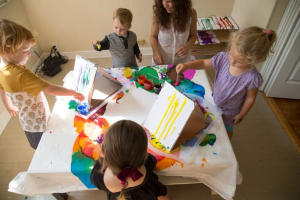
Let preschoolers experiment with gravity and color mixing by creating bubble drip paintings. Hang a large sheet of paper on a wall or easel and pour different colors of bubble solution near the top. As the bubbles slowly drip down the paper, they will leave behind unique trails of color. Children can observe the mesmerizing patterns and create their own imaginative interpretations.
Related: 20 Mess Free Activities for Toddlers
Bubble Printing with Bubble Wands:
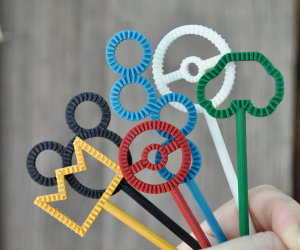
Take traditional bubble blowing to the next level by using bubble wands as printing tools. Dip bubble wands of different shapes and sizes into a tray of paint, and then press them onto paper to create beautiful bubble prints. Preschoolers will enjoy experimenting with different wands and observing the unique patterns they create. This activity allows children to engage their senses and develop their artistic skills simultaneously.
Bubble Resist Art:

Introduce the concept of resist art to preschoolers by combining bubbles and crayons. Have children draw colorful designs on a sheet of paper using crayons. Once the drawings are complete, encourage them to blow bubbles onto the paper. The bubbles will land on the wax from the crayons, creating a unique resist effect. Kids will delight in seeing their designs emerge through the colorful bubble patterns.
Bubble Painting Collage:

Combine bubble painting with collage techniques to create multi-dimensional artwork. Provide preschoolers with a variety of materials such as colored paper, tissue paper, buttons, and feathers. After creating bubble prints on individual sheets of paper, have the children cut out different shapes and textures from the bubble prints and glue them onto a larger background. This collaborative project will result in a vibrant and textured masterpiece.
Bubble Printing Nature Art:
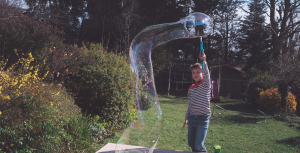
Take bubble painting outdoors and incorporate elements from nature. Head to the park or your backyard and gather leaves, flowers, and twigs. Dip these natural objects into a tray of bubble solution, press them gently onto paper, and blow bubbles around them. The bubbles will create beautiful patterns and colors, enhancing the natural shapes imprinted on the paper. This activity allows preschoolers to explore the beauty of nature while experimenting with bubble art.
Bubble Splatter Painting:
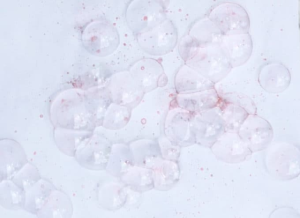
For a more energetic and messy bubble painting experience, try bubble splatter painting. Fill a large container with bubble solution and add a few drops of liquid watercolor or food coloring for vibrant splatters. Encourage preschoolers to use various tools like straws or flyswatters to blow or swat the bubbles, creating splatter patterns on a large sheet of paper or an easel. This activity is sure to spark excitement and laughter as the colorful bubbles burst into the air.
Bubble Sun Catchers:

Combine bubble painting with a craft activity by creating bubble sun catchers. Cut out different shapes from clear plastic sheets or transparent contact paper. Invite preschoolers to decorate the shapes with bubble prints and add embellishments like glitter or sequins. Once dry, hang the sun catchers near a window, and watch as the sunlight passes through the colorful bubble patterns, casting a mesmerizing display of colors in the room.
Bubble Dot Painting:
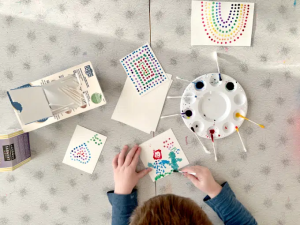
Introduce preschoolers to the concept of pointillism with bubble dot painting. Prepare a tray of bubble solution and add a few drops of different colored liquid watercolors or food coloring. Provide children with cotton swabs or Q-tips and encourage them to dip the ends into the bubble solution, then gently dot the paper to create colorful bubble dots. As they experiment with different colors and dot sizes, preschoolers will discover the magic of creating images through tiny dots.
Bubble Silhouette Art:
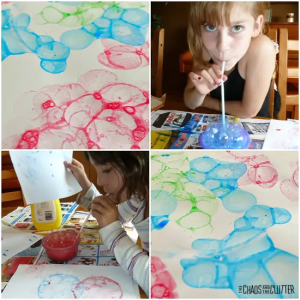
Combine bubble painting with the art of silhouette to create stunning compositions. Have preschoolers paint a sheet of paper with different colors using bubble blowing or bubble printing techniques. Once dry, provide them with black construction paper and scissors to cut out various shapes like animals, trees, or objects. Glue the black silhouettes onto the colorful bubble-painted background to create a striking contrast and visual interest.
Bubble Rainbow Art:

Explore the beauty of rainbows with bubble painting. Prepare a tray of bubble solution and add different colors of liquid watercolors or food coloring in rainbow order. Provide preschoolers with a large sheet of paper and encourage them to blow bubbles onto the paper using bubble wands. As the bubbles burst, they will create vibrant, overlapping colors reminiscent of a rainbow. This activity not only introduces colors but also engages children in scientific observations of bubble interactions.
Bubble Spray Bottle Painting:
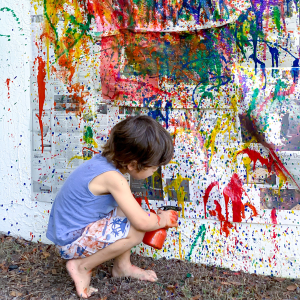
Switch up the tools for bubble painting by using spray bottles. Fill spray bottles with bubble solution and add liquid watercolors or food coloring for a colorful effect. Take the activity outdoors or protect the workspace with a large tarp. Let preschoolers spray the bubble solution onto paper, creating a mist of colorful bubbles. They can experiment with different spraying techniques and observe the patterns that emerge from the bubble mist.
Bubble Stamping with Fruits and Vegetables:
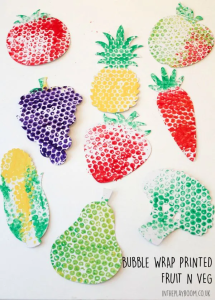
Engage preschoolers in a sensory exploration of fruits and vegetables while creating bubble stamps. Cut various fruits and vegetables like apples, potatoes, or bell peppers in half. Dip the cut side into a tray of bubble solution and press it onto paper to create unique bubble prints. Children can discover the different textures and shapes each fruit or vegetable produces, while the bubbles add an element of surprise to their stamping creations.
Bubble Marbling:
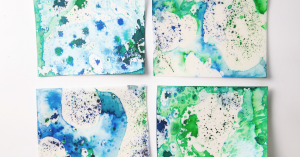
Introduce preschoolers to the mesmerizing art of marbling using bubbles. Fill a shallow tray with a mixture of water and liquid watercolors or food coloring. Add a few drops of liquid dish soap to create surface tension. Encourage children to blow bubbles directly into the tray, creating colorful patterns and swirls. Once the bubbles reach the surface, place a sheet of paper gently on top to transfer the marbled design. Each print will be a unique and beautiful creation!
Bubble Spin Art:
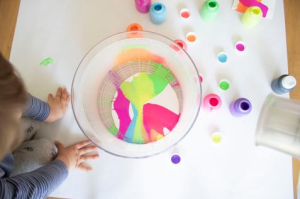
Put a twist on traditional spin art by incorporating bubbles into the process. Attach a sheet of paper to a spinner or a salad spinner. Dip bubble wands or pipettes into bubble solution mixed with liquid watercolors or food coloring, and then drop the solution onto the spinning paper. As the paper rotates, the bubbles will create vibrant and dynamic patterns. Preschoolers will be amazed at the captivating designs they can create with a simple spinning motion.
Bubble Sculptures:
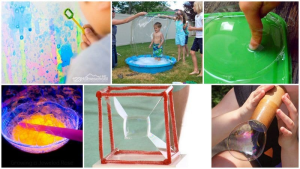
Encourage preschoolers to explore the three-dimensional aspect of bubble painting by creating bubble sculptures. Provide them with pipe cleaners or wire to shape them into different forms like flowers, animals, or abstract shapes. Dip the sculptures into a bubble solution mixed with liquid watercolors or food coloring, then blow bubbles around them. The bubbles will cling to the wire structures, creating a fascinating and colorful bubble-covered sculpture.
Bubble Painting with Toy Cars:
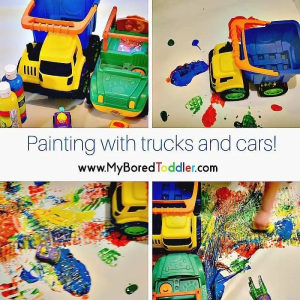
Combine the excitement of toy cars with bubble painting to create tracks of colorful art. Lay a large sheet of paper on the floor or outdoors and pour different colors of bubble solution onto the paper. Let preschoolers dip the wheels of toy cars into the bubbles and drive them along the paper, leaving behind vibrant tracks. They can experiment with different cars and colors, creating their own unique racecourse artwork.
Bubble Mosaic Art:
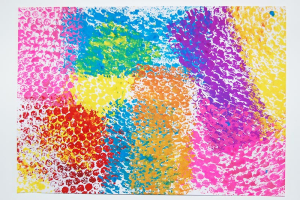
Inspire preschoolers to create beautiful mosaic-like artworks using bubble prints. Prepare sheets of paper in different colors and cut them into small squares or triangles. Dip bubble wands or other bubble tools into a variety of colored bubble solutions and press them onto the paper squares. Preschoolers can arrange the bubble-printed squares into a larger composition, creating a stunning mosaic artwork. This activity promotes color recognition, spatial awareness, and creativity.
